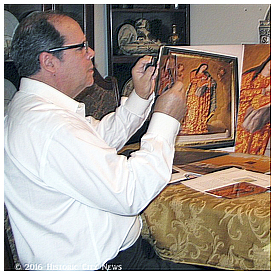
Raphael Cosme
Special to Historic City News
This May, after many years of work trying to bring one of the most prestigious pieces of art in Florida’s history, a 1700’s painting “Our Lady of la Leche”, the government of Mexico turned down a request for a temporary display of the painting on U.S soil.
The Orange County Regional Museum was very interested in receiving the painting of “Our Lady of la Leche” for exhibit during Spanish Heritage Month. Museums in St. Augustine were also eager to enjoy this important painting that was part of the town’s history more than 200 years ago.
According to historian Raphael Cosme, Spanish settlers started building the first devotional shrine to house the painting of Our Lady of la Leche in the United States in the early 1600s. Images in the form of statues and canvases of Our Lady of La Leche were created, but most of these works of art were destroyed during the British attacks on St. Augustine.
In the early days of March in 1728, soldiers, made up of Englishmen and Indians from Georgia sent by Colonel John Palmer, attacked St. Augustine, the Mission of Nombre de Dios and its sanctuary. During the attack a woman tried to save a painting of the Virgin Mary from the burning church but the attackers made their way to her and took it from her arms.
Between 1728 through 1737 a church with a bell tower dedicated to Our Lady of La Leche, also known as the Iglesia del Pueblo de Nombre de Dios, was made using the coquina stones of the church destroyed by the British. A map made by Sam Roworth in 1765 marked the church at about 2,500 feet north of the Castillo de San Marcos.
In 1760, an unknown painter with great artistic talent painted a second variation of Our Lady of La Leche and placed it at the Iglesia del Pueblo Nombre de Dios. With the Paris Treaty between Spain and England the peninsula of Florida was released to the British in exchanged for Havana, Cuba in 1763. As a result, over 3,000 St. Augustinians and Spaniards abandoned St. Augustine. To prevent the items from being destroyed by the invaders as they were fleeing Florida, residents took with them treasures from the churches of St. Augustine including crucifixes, chalices, candlesticks, church records of baptisms, funerals and weddings, legal documents, religious art and the painting of “Our Lady of la Leche”. The people relocated to Havana, Cuba and later to Campeche, Mexico and other Caribbean islands. After Florida was given back to Spain in 1784, none of the items exported to other countries, the religious, historic, and personal items including the painting of “Our Lady of La Leche” were returned to the original owner – now the city of St. Augustine.
Hoping to find a way to bring the precious painting home to St. Augustine, Cosme began searching for the painting in September of 2012. He got his first tip on October 14, 2014 from an art researcher in Southern Mexico who confirmed seeing the painting in a photo in an old church in the city of Campeche, Mexico. In the same year on December 5, Cosme located the painting of “Our Lady of la Leche” at the Campeche Cathedral in a small colonial type room converted into a small museum.
Cosme returned to St. Augustine and created the group “Our Lady of la Leche Delegation” to initiate negotiations with Mexico to bring the Lady to Florida for exhibition.
On December 21, 2015, the Our Lady of la Leche Delegation met with representatives of the Institute of Anthropology and History (INAH) who would have the last word of the exportation of the painting to Florida. In May of this year the INAH denied the request in a letter to the Delegation claiming that the painting had become a devotional “Cult” for the people of the city of Campeche, Mexico – something that is hard to believe since no one in that city knew anything about the existence of such painting and, furthermore, in the last five hundred years there had never been a devotion to the La Leche Virgin in any part of the country.
In 1987, when the Campeche Regional Museum restored the painting Mr. Rafael Burgos Villanueva, an archaeologist, reported in the “Cuaderno de Arquitectura Virreinal- Nuestra Señora de la Leche” – “We haven’t found any evidence at the part of the peninsula of Yucatan of the devotion to the Virgin Our Lady of la Leche, and for that reason we think that the painting donated to the Regional Museum came from the exterior. It’s still probable that the image of Our Lady of la Leche was painted in St. Augustine, Florida.”
In December of 2015 historian Miguel Bretos from Miami, Florida published an article about the Nuestra Señora de la Leche (Our Lady of la Leche) in the “Por Esto” newspaper in Yucatan, Mexico and was quoted that the painting was “transfered to Havana, Cuba and then later end with the St. Franciscan order in the City of Campeche”.
There is no doubt that many people want to see the lady back in St. Augustine. Especially when the devotion of Our Lady of La Leche goes back to the founding of St. Augustine in 1565 and the first veneration of the Virgin in the southeast United States began in St. Augustine.
The Shrine replica at the Mission of Nombre de Dios built at the turn of the 20th Century, contains a statue from the 1900s of Our Lady of La Leche happily breastfeeding, beautifully displayed in the Chapel.
So far the oldest painting associated with the devotion of Our Lady of La Leche in the United States is the one displayed at the Chapel in Campeche and is the patroness from the state of Florida for the Catholics that followed. It is a loss for the city of St. Augustine to not have the 1700s painting back where she is truly venerated and belongs.
Mr. Cosme has decided to end the project for any future request for the painting of “Our Lady of la Leche” from Mexico. All his letters and research has been donated to the St. Augustine Historical Library for any citizen who wants to ask the government of Mexico to reconsider its decision and to let the Lady return to her original home.
Discover more from HISTORIC CITY NEWS
Subscribe to get the latest posts sent to your email.












